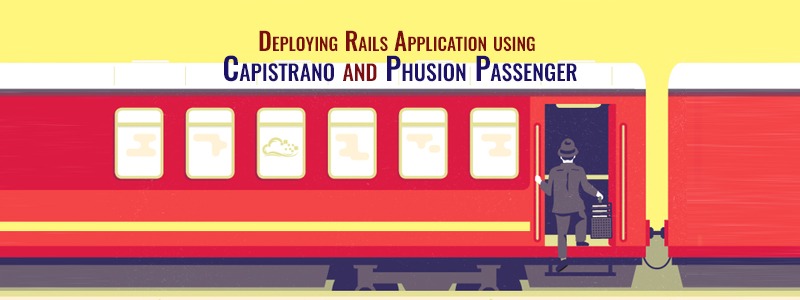Dans le paysage commercial concurrentiel d'aujourd'hui, les startups et les entreprises sont constamment à la recherche de moyens pour créer des applications web de haute qualité tout en minimisant les coûts. C'est là qu'intervient Ruby on Rails (RoR), un framework puissant et rentable qui permet aux développeurs de créer efficacement des solutions web robustes. Dans ce blog, nous allons voir comment Ruby on Rails permet de développer des applications web de manière rentable, ce qui en fait un choix incontournable pour les entreprises de toutes tailles.
Qu’est-ce que Ruby on Rails ?
Ruby on Rails, souvent appelé simplement Rails ou RoR, est un cadre d'application web open-source écrit dans le langage de programmation Ruby. Il a été créé par David Heinemeier Hansson (souvent connu sous le nom de DHH) et publié en 2004 comme un sous-produit de son travail sur Basecamp, un outil de gestion de projet.
Ruby on Rails suit le modèle architectural Modèle-Vue-Contrôleur (MVC), qui sépare une application en trois composants interconnectés :
- Modèle : Représente les données et la logique d'entreprise de l'application. Les modèles interagissent avec la base de données pour effectuer les opérations suivantes CRUD (Créer, Lire, Mettre à jour, Supprimer) des opérations sur les données.
- Vue : Elle gère la couche de présentation de l'application, rend les interfaces utilisateur et répond aux interactions de l'utilisateur. Les vues sont généralement écrites en HTML avec du code Ruby intégré (ERB) ou d'autres langages de modélisation.
- Contrôleur : Il sert d'intermédiaire entre le modèle et les composants de la vue, en gérant les demandes des utilisateurs, en traitant les données d'entrée et en orchestrant les interactions entre les différentes parties de l'application.
Ruby on Rails met l'accent sur les conventions plutôt que sur la configuration, ce qui signifie que les développeurs suivent un ensemble de conventions et de bonnes pratiques prédéfinies plutôt que de devoir spécifier chaque détail de la configuration de leur application. Cette approche axée sur les conventions rationalise le développement et encourage la cohérence entre les projets.
Voici quelques caractéristiques et principes clés de Ruby on Rails :
- Ne pas se répéter (DRY) : Encourage les développeurs à écrire un code concis, modulaire et réutilisable, ce qui permet de réduire les doublons et d'améliorer la maintenabilité.
- Convention over Configuration (CoC) : Fournit des conventions par défaut et des valeurs par défaut raisonnables pour la configuration, réduisant ainsi la nécessité d'une configuration manuelle et d'un code de type "boilerplate".
- Active Record : Ruby on Rails comprend une bibliothèque de mappage objet-relationnel (ORM) appelée Enregistrement actifqui simplifie les interactions avec les bases de données en faisant abstraction des complexités des requêtes SQL et de la gestion des bases de données.
- Routage RESTful : encourage l'utilisation des principes REST (Representational State Transfer) pour concevoir des API propres et orientées vers les ressources et définir des itinéraires qui mettent en correspondance les méthodes HTTP et les actions du contrôleur.
- Échafaudage : Génère un code type pour les tâches courantes telles que la création, la lecture, la mise à jour et la suppression de ressources, ce qui permet aux développeurs de lancer rapidement de nouveaux projets.
- Cadre de test : Ruby on Rails comprend un cadre de test intégré qui prend en charge les tests unitaires, les tests d'intégration et les tests système, ce qui favorise le développement piloté par les tests (TDD) et garantit la qualité et la fiabilité du code.
Dans l'ensemble, Ruby on Rails est réputé pour sa syntaxe conviviale pour les développeurs, son design élégant et l'accent mis sur la productivité et le bonheur des développeurs. Il a été largement adopté par les startups, les petites entreprises et les grandes entreprises pour créer des applications web évolutives, faciles à maintenir et de haute qualité.
Quels sont les facteurs qui influencent le coût du développement d'une application Ruby On Rails ?
Plusieurs facteurs peuvent influencer le coût de développement d'une application Ruby on Rails (RoR) :
Portée du projet :
La complexité et l'étendue du projet ont un impact significatif sur les coûts de développement. Une simple application web avec des fonctionnalités de base sera moins coûteuse à développer qu'une application d'entreprise à grande échelle avec des fonctionnalités étendues, des intégrations et des personnalisations.
Exigences en matière de conception :
La complexité de la conception de l'interface utilisateur (UI) et de l'expérience utilisateur (UX) peut avoir une incidence sur les coûts de développement. Les conceptions personnalisées, les animations complexes et les mises en page réactives peuvent nécessiter plus de temps et de ressources pour être mises en œuvre, ce qui augmente les coûts de développement.
Caractéristiques et fonctionnalités :
Le nombre et la complexité des caractéristiques et des fonctionnalités requises dans l'application ont un impact direct sur les coûts de développement. L'intégration d'API tierces, la mise en œuvre de fonctionnalités avancées (par exemple, les mises à jour en temps réel, les services de géolocalisation) et le développement d'une logique commerciale complexe sont autant de facteurs qui contribuent à l'augmentation des coûts de développement.
Complexité des bases de données :
La complexité de la conception de la base de données, y compris le nombre d'entités, les relations et les exigences en matière de manipulation des données, peut avoir une incidence sur les coûts de développement. Les structures de base de données complexes et les exigences d'optimisation peuvent nécessiter plus de temps de développement et d'expertise, ce qui entraîne des coûts plus élevés.
Exigences d'intégration :
L'intégration de l'application de RdR avec des systèmes externes, des services ou des API de tiers peut augmenter les coûts de développement. La complexité de l'intégration, la disponibilité de la documentation et les exigences en matière de synchronisation et de sécurité des données peuvent influer sur le coût global du développement.
Évolutivité et performance :
La création d'une application de RdR évolutive et performante peut nécessiter des efforts de développement et des ressources supplémentaires. La mise en œuvre de mécanismes de mise en cache, l'optimisation des requêtes de base de données et la conception d'une architecture évolutive pour gérer des volumes de trafic croissants peuvent contribuer à l'augmentation des coûts de développement.
Essais et assurance de la qualité :
Des processus complets de test et d'assurance qualité sont essentiels pour garantir la fiabilité, la sécurité et la fonctionnalité de l'application de RdR. Investir dans des tests approfondis, y compris des tests unitaires, des tests d'intégration et des tests d'acceptation par l'utilisateur, peut augmenter les coûts de développement, mais permet d'éviter des erreurs et des problèmes coûteux à long terme.
Calendrier du projet :
Le calendrier de développement de l'application de RdR peut avoir un impact sur les coûts de développement. Des délais trop courts peuvent nécessiter des ressources supplémentaires et des heures supplémentaires, ce qui entraîne des coûts plus élevés. Un calendrier de projet réaliste et bien planifié peut aider à gérer efficacement les coûts.
Tarifs et expertise des développeurs :
Les tarifs pratiqués par les développeurs RdR et leur niveau d'expertise peuvent varier en fonction de facteurs tels que la localisation, l'expérience et le niveau de compétence. Embaucher des développeurs expérimentés qui ont l'habitude de fournir des applications de RdR de qualité peut se traduire par des tarifs horaires plus élevés, mais peut en fin de compte déboucher sur un projet plus fructueux et plus rentable.
Maintenance et soutien :
Il convient de prendre en considération les coûts de maintenance et d'assistance pour l'application de RdR. Cela comprend les mises à jour, les corrections de bogues, les correctifs de sécurité et l'assistance continue aux utilisateurs. La planification de la maintenance et de l'assistance à long terme permet de garantir la durabilité et le succès de l'application au-delà de la phase de développement initiale.
Développement Web rentable avec Ruby on Rails
Processus de développement rationalisé
L'une des principales raisons pour lesquelles Ruby on Rails est réputé pour son efficacité en matière de développement web est son processus de développement rationalisé. RoR suit le principe de la convention plutôt que de la configuration, ce qui signifie que les développeurs peuvent s'appuyer sur des conventions prédéfinies et des valeurs par défaut pour démarrer rapidement sans perdre de temps sur le code de base. Il en résulte des cycles de développement plus rapides, une complexité réduite et, en fin de compte, des coûts de développement moindres.
Un vaste écosystème de pierres précieuses
Ruby on Rails dispose d'un riche écosystème de bibliothèques, d'outils et d'extensions appelés "gems". Ces gems couvrent un large éventail de fonctionnalités, de l'authentification et de l'autorisation au traitement des paiements et à la mise en cache. En exploitant les gems existants, les développeurs peuvent éviter de réinventer la roue et accélérer le développement, réduisant ainsi de manière significative le temps et les coûts de développement.
Efficacité et productivité des développeurs
Ruby, le langage de programmation qui sous-tend Ruby on Rails, est réputé pour sa simplicité, sa lisibilité et sa syntaxe conviviale pour les développeurs. Cela permet aux développeurs d'écrire un code propre et concis plus rapidement, ce qui se traduit par une productivité et une efficacité accrues. En outre, le cadre de test intégré de RoR encourage le développement piloté par les tests (TDD), ce qui garantit la qualité du code tout en minimisant le temps et les efforts consacrés au débogage et à la maintenance.
Open-Source et gratuit
L'un des aspects les plus attrayants de Ruby on Rails pour les entreprises soucieuses de leur budget est qu'il s'agit d'un logiciel libre dont l'utilisation est gratuite. Il n'y a pas de frais de licence ou de coûts initiaux associés à RoR, ce qui en fait une option accessible pour les startups et les entreprises aux budgets limités. En outre, la nature open-source de RoR signifie que les développeurs peuvent bénéficier d'une communauté mondiale de contributeurs qui maintiennent et améliorent activement le framework.
Évolutivité et économies à long terme
Si Ruby on Rails excelle dans le développement web rentable pour les startups et les petites entreprises, il offre également une évolutivité pour la croissance à long terme. Au fur et à mesure que les entreprises se développent et que leur base d'utilisateurs augmente, l'architecture modulaire et les fonctions d'évolutivité de RoR permettent une mise à l'échelle transparente sans augmentation significative des coûts. Les entreprises peuvent ainsi continuer à faire évoluer leurs applications web de manière rentable au fur et à mesure que leurs besoins changent.
Quel est le coût de la création d'une application Web en Ruby on Rails : Tarification géographique ?
Le coût de la création d'une application web en Ruby on Rails (RoR) peut varier considérablement en fonction de la situation géographique de l'équipe de développement. Les coûts de la main-d'œuvre, les conditions du marché et les facteurs économiques qui influencent les prix varient d'une région à l'autre. Voici un aperçu général de la manière dont la tarification géographique peut influer sur le coût de création d'une application web en RoR :
- Amérique du Nord (États-Unis, Canada) :
-
-
- En Amérique du Nord, les coûts de développement sont généralement plus élevés que dans les autres régions, en raison des taux de main-d'œuvre et des frais d'exploitation plus élevés.
- Aux États-Unis, en particulier dans les centres technologiques comme la Silicon Valley, New York City ou San Francisco, les tarifs de développement peuvent aller de $100 à $250 par heure ou plus pour les développeurs de RdR expérimentés.
- Le Canada propose également des tarifs compétitifs, avec des taux horaires allant de $80 à $150 pour les développeurs de RdR qualifiés.
-
- Europe (Royaume-Uni, Allemagne, Europe de l'Est) :
-
-
- Les pays européens offrent une gamme variée de taux de développement, les pays d'Europe occidentale ayant généralement des taux plus élevés que les pays d'Europe de l'Est.
- Au Royaume-Uni, les taux horaires pour les Développement du RoR peut aller de 60 à 150 livres sterling, voire plus.
- L'Allemagne et d'autres pays d'Europe occidentale peuvent appliquer des tarifs similaires, généralement compris entre 60 et 150 euros de l'heure.
- Les pays d'Europe de l'Est comme l'Ukraine, la Pologne et la Roumanie offrent des tarifs plus compétitifs, avec des taux horaires allant de $30 à $80 pour les développeurs RdR qualifiés.
-
- Asie (Inde, Asie du Sud-Est) :
-
-
- Les pays asiatiques sont connus pour offrir des taux de développement plus rentables que les pays occidentaux.
- En Inde, les taux horaires pour le développement de RdR peuvent aller de $20 à $50, selon le niveau d'expertise et d'expérience.
- Les pays d'Asie du Sud-Est comme le Vietnam, l'Indonésie et les Philippines proposent des tarifs encore plus bas, allant généralement de $15 à $40 par heure pour le développement de la RdR.
-
- Amérique latine (Brésil, Mexique, Argentine) :
-
-
- Les pays d'Amérique latine offrent des tarifs compétitifs et sont réputés pour leurs développeurs qualifiés.
- Au Brésil, les taux horaires pour le développement de la RdR peuvent aller de $30 à $80, tandis qu'au Mexique et en Argentine, les taux peuvent aller de $25 à $60 par heure.
-
- Océanie (Australie, Nouvelle-Zélande) :
-
- L'Océanie a tendance à avoir des coûts de développement plus élevés que l'Amérique du Nord et l'Europe occidentale.
- En Australie, les taux horaires pour le développement de la RdR peuvent aller de $100 à $200 AUD ou plus.
- En Nouvelle-Zélande, les tarifs peuvent être légèrement inférieurs, allant généralement de $80 à $150 dollars néo-zélandais par heure.
Conclusion
Ruby on Rails se distingue comme une solution rentable pour le développement web, offrant des processus de développement rationalisés, un vaste écosystème de joyaux, l'efficacité des développeurs et l'accessibilité au code source ouvert. En tirant parti des atouts de RoR, les entreprises peuvent créer des applications web de haute qualité de manière efficace tout en minimisant les coûts de développement. Que vous soyez une startup cherchant à lancer son premier produit ou une entreprise établie cherchant à optimiser ses coûts, Ruby on Rails fournit un cadre convaincant pour un développement web rentable. Pour en savoir plus, contactez RailsCarma.





